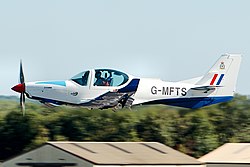| RAF Barkston Heath | |||||||||||
|---|---|---|---|---|---|---|---|---|---|---|---|
| Near Grantham, Lincolnshire in England | |||||||||||
 A Grob Prefect T1 based at Barkston Heath | |||||||||||
| Site information | |||||||||||
| Type | Relief Landing Ground | ||||||||||
| Owner | Ministry of Defence | ||||||||||
| Operator | Royal Air Force | ||||||||||
| Controlled by | No. 22 Group (Training) | ||||||||||
| Condition | Operational | ||||||||||
| Location | |||||||||||
| Coordinates | 52°57′44″N000°33′42″W / 52.96222°N 0.56167°W | ||||||||||
| Area | 224 hectares (550 acres) [1] | ||||||||||
| Site history | |||||||||||
| Built | 1938 | ||||||||||
| In use | 1938–1943 (Royal Air Force) 1943–1945 (US Army Air Force) 1945 – present (Royal Air Force) | ||||||||||
| Garrison information | |||||||||||
| Occupants | 57 Squadron | ||||||||||
| Airfield information | |||||||||||
| Identifiers | ICAO: EGYE | ||||||||||
| Elevation | 111.8 metres (367 ft) AMSL | ||||||||||
| |||||||||||
| Source: UK MIL AIP Barkston Heath [2] | |||||||||||
Royal Air Force Barkston Heath or RAF Barkston Heath( ICAO : EGYE) is a Royal Air Force Relief Landing Ground under the command of RAF Cranwell near Grantham, Lincolnshire, England.
Contents
- History
- United States Army Air Forces use
- Royal Air Force use
- Other units
- Infrastructure and facilities
- Role and operations
- Defence Elementary Flying Training School
- Relief Landing Ground
- Based units
- Royal Air Force
- See also
- References
- Citations
- Bibliography
- External links
RAF Barkston Heath is the home of 57 Sqn's B Flight of No. 3 Flying Training School RAF (3 FTS). For a period between approximately 1995 and 2010, it operated the Slingsby T67M260 Firefly, followed by the Grob Tutor T.1 operated between 2010 and 2018.
No. 3 FTS currently provide elementary flying training for RAF and Royal Navy students on the Grob Prefect T.1. A secondary role of RAF Barkston Heath is as a Relief Landing Ground for the flying training activities at RAF Cranwell.







